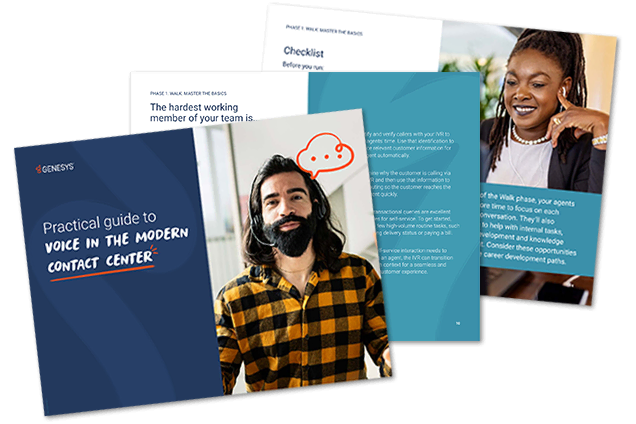Your Genesys Blog Subscription has been confirmed!
Please add genesys@email.genesys.com to your safe sender list to ensure you receive the weekly blog notifications.
Subscribe to our free newsletter and get blog updates in your inbox
Don't Show This Again.

Voice used to be the first — and often only — way for customers to engage when they needed support or service. Even though customers have embraced an array of options with digital channels, self-service and bot-led experiences, voice isn’t going anywhere. And what customers expect from voice has evolved.
Customers have grown accustomed to the speed and 24/7 convenience of digital engagement. They expect the same efficiency when speaking to an agent. They won’t accept being put on a lengthy hold, being transferred to a different agent or having to repeat themselves. They expect a quick, nearly effortless resolution.
To meet these customer expectations, you need to modernize your approach to voice. Here’s how.
No two customers are alike. Some would prefer to contact your company via phone to make a purchase, solve a problem or get the information they need. And they want that to be in one seamless session — with a single customer service agent.
Others might not want to speak with an agent, preferring to use self-service options or interact with an artificial intelligence (AI)-powered chatbot. And still other customers might have complicated questions or need specific information that only a highly skilled agent can handle. According to Genesys benchmark data, voicebot results in a 60–70% reduction in volume interactions.*
One way these customers are alike is that they all expect a smooth conversation that meets their needs quickly and efficiently. The longer the wait time, the higher the customer frustration climbs.

Voice still matters in the contact center, and it should still be at the heart of your omnichannel strategy. Modernize your voice strategy today.
Offering automatic callback lets customers schedule a return call or callback at a time that’s convenient to them. Automatic callbacks not only benefit the customer, but they also reduce wait times — and that can cut costs.
Adding a callback capability can also reduce customer frustrations. Genesys benchmark data shows that implementing callback can reduce AHT by 30–35%. This leads to a 3–5% reduction in customer venting time — the time a customer spends voicing dissatisfaction for being on hold, upon first speaking with an agent.
But understanding your customers’ expectations doesn’t just involve knowing how they prefer to contact you. It also involves being able to detect how they feel when they contact you — and directing the engagement accordingly.
While digital or bot interactions are fast and efficient ways to help more a satisfied customer through resolution, they aren’t always equipped to detect sentiments like frustration or excitement. It’s important to properly train your contact center agents so they an detect and handle the emotional ups and downs in a conversation. Sometimes these are opportunities to turn a frustrated caller into a satisfied customer — and brand ambassador.
Empathy is a skill that agents can develop with training in active listening, emotional intelligence and communication techniques. But those soft skills only go so far if the agent can’t solve a customer’s problem.
As customers increasingly use voice for complex questions and to escalate issues that weren’t resolved in other channels, agents need thorough product knowledge and advanced problem-solving skills. They must understand the customer. And that requires background, conversation history and context. You need to show you place a high value on your customers’ time — and that you value them.
When agents know as much as possible about the customer, including their journey, preferences and interaction history, they give customers a satisfying experience that makes them feel listened to and understood.
With systems integrations, a robust IVR and conversational AI, you can gather that information before the call reaches the contact center — and then surface those insights to guide the customer service agent throughout the conversation. Agents can focus more effectively on the customer instead of having to ask unnecessary questions and search for information.
A well-designed IVR system allows you to collect information, accurately identify a caller’s intent, and automate repetitive or routine tasks. It connects voicebots, reusable modules and back-end systems to efficiently meet customers’ needs.
By adding agents’ individual skill proficiencies to your routing algorithms, you can be sure the customer is connected to someone with the best skills for resolving the issue. And you can blend voice with digital channels to ensure customers quickly transition from a bot to an agent when a more personal touch is needed.
To further optimize your use of voice in the customer experience, you need to understand the types of issues and questions that lead to calls with a contact center agent. You can find the answers you need in your data.
Your data can reveal which automated features best solve customer problems — and which ones don’t. Invest in those use cases that are working well and re-evaluate the others.
And with a deeper understanding of the customer journey and the most common reasons they reach for the phone, your agents are better prepared to deliver exceptional service. Use this data to nurture knowledge management so agents have the information and guidance necessary to address customers’ questions. This has shown to cut agent handled volume by 15–20%, according to Genesys benchmark data.
Your contact center agents often are the face and voice of your company. They can create exceptional customer experiences. And because voice remains a critical channel to optimize those customer experiences and drive business outcomes, you need a modern approach.
To learn how to modernize voice in your contact center, download our practical guide today.
*This benchmark data is made up of learnings from past business cases Genesys has built for customers, with the ranges of benefits representing a median average of impact they have perceived as potential optimization for their operations and maturity at the time. Individual results may vary.
Subscribe to our free newsletter and get blog updates in your inbox.